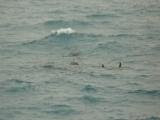
The currents meters were deployed into a bamboo-coral-rich area of The Gully which we surveyed in 2007. ROPOS placed them on the sea floor using its manipulator arms. One current meter was placed in an area full of corals, and its matching current meter in an area without corals, about 50 m away.
Comparing
 the two will allow Memorial University physical oceanographer Len Zedel to determine how corals affect
the two will allow Memorial University physical oceanographer Len Zedel to determine how corals affect  the way water flows over the bottom. While Dr. Zedel was not able to actually be on board the ship, he directed the placement of his current meters by watching a live video feed from ROPOS over the internet, and communicating with us over satellite transmitted telephone and text messaging.
the way water flows over the bottom. While Dr. Zedel was not able to actually be on board the ship, he directed the placement of his current meters by watching a live video feed from ROPOS over the internet, and communicating with us over satellite transmitted telephone and text messaging.We continued the dive exploring steep bedrock wall habitats, and the intervening small canyons filled with sand and mud. The bedrock here is quite soft, and we saw several places where blocks of
 the bedrock had broken free. In a few cases, the broken blocks had since been colonized by brightly coloured "bubblegum coral".
the bedrock had broken free. In a few cases, the broken blocks had since been colonized by brightly coloured "bubblegum coral".We were also looking for a smaller species of bamboo coral, which usually grows in sandy
 or muddy bottoms, for the coral reproduction study. We were aiming for places where we had seen this species in 2007, but we did not find them.
or muddy bottoms, for the coral reproduction study. We were aiming for places where we had seen this species in 2007, but we did not find them.We did find a rare species of sea pen, and a rare, very long-lived clam, and some of the solitary cup corals that we hope to collect from Orphan Knoll.

Underwater photos copyright Canadian Scientific Submersible Facility.
During our dive, we also saw a pod of Pilot Whales on the surface. The whales live in The Gully year-round, and are one of the reasons why The Gully was protected as Atlantic Canada's largest Marine Protected Area.


Whale photos by Luc Baillargeon-Nadeau.
We have begun our 2 day steam to the Flemish Cap.
No comments:
Post a Comment